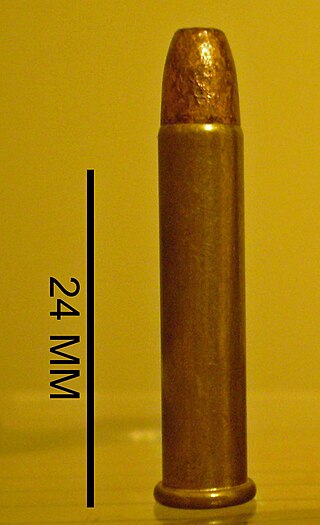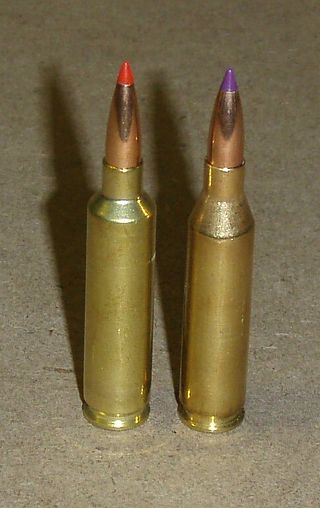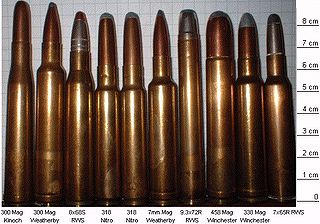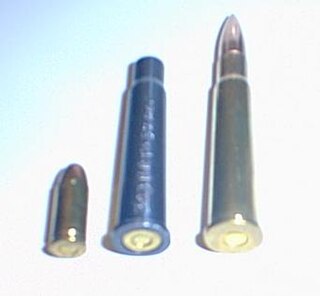
A cartridge, also known as a round, is a type of pre-assembled firearm ammunition packaging a projectile, a propellant substance and an ignition device (primer) within a metallic, paper, or plastic case that is precisely made to fit within the barrel chamber of a breechloading gun, for convenient transportation and handling during shooting. Although in popular usage the term "bullet" is often used to refer to a complete cartridge, the correct usage only refers to the projectile.

A rim-fire is a type of metallic cartridge used in firearms, where the primer is located within a hollow circumferential rim protruding from the base of its casing. When fired, the gun's firing pin will strike and crush the rim against the edge of the barrel breech, sparking the primer compound within the rim, and in turn ignite the propellant within the case. Invented in 1845, by Louis-Nicolas Flobert, the first rimfire metallic cartridge was the .22 BB Cap cartridge, which consisted of a percussion cap with a bullet attached to the top. While many other different cartridge priming methods have been tried since the early 19th century, such as teat-fire and pinfire, only small caliber rimfire and centerfire cartridges have survived to the present day with regular use. The .22 Long Rifle rimfire cartridge, introduced in 1887, is by far the most common ammunition found in the world today in terms of units manufactured and sold.

The .22 Long Rifle, also known as the .22LR or 5.6×15mmR, is a long-established variety of .22 caliber rimfire ammunition originating from the United States. It is used in a wide range of firearms including rifles, pistols, revolvers, and submachine guns.
Internal ballistics, a subfield of ballistics, is the study of the propulsion of a projectile.

The .223 Remington is a rimless, bottlenecked, centerfire rifle cartridge. It was developed in 1957 by Remington Arms and Fairchild Industries for the U.S. Continental Army Command of the United States Army as part of a project to create a small-caliber, high-velocity firearm. The .223 Remington is considered one of the most popular common-use cartridges and is currently used by a wide range of semi-automatic and manual-action rifles.

The .22 CB cap (Conical Bullet Cap), also known as the 6mm Flobert, is a more powerful version of the .22 BB cap rimfire metallic cartridge, which was invented by Louis-Nicolas Flobert in 1845. The .22 BB cap and .22 CB cap are interchangeable and are relatively quiet, low velocity cartridges, designed for indoor target shooting.

.22 BB Cap, also known as the 6mm Flobert, is a variety of .22 caliber rimfire ammunition. Invented by Louis-Nicolas Flobert in 1845, it was the first rimfire metallic cartridge. The .22 BB Cap and .22 CB Cap are interchangeable and are relatively quiet low velocity cartridges, designed for indoor target shooting.

.22 Short is a variety of .22 caliber (5.6 mm) rimfire ammunition. Developed in 1857 for the first Smith & Wesson revolver, the .22 rimfire was the first American metallic cartridge. The original loading was a 29 or 30 gr bullet and 4 gr of black powder. The original .22 rimfire cartridge was renamed .22 Short with the introduction of the .22 Long in 1871.

The .22 Winchester Magnum Rimfire, also known as the .22 WMR, .22 Magnum, .22 WMRF, .22 MRF, or .22 Mag, is a rimfire cartridge. Originally loaded with a bullet weight of 40 grains (2.6 g) delivering velocities in the 2,000 feet per second (610 m/s) range from a rifle barrel, .22 WMR is now loaded with bullet weights ranging from 50 grains (3.2 g) at 1,530 feet per second (470 m/s) to 30 grains (1.9 g) at 2,200 feet per second (670 m/s).

A wildcat cartridge, often shortened to wildcat, is a custom cartridge for which ammunition and/or firearms are not mass-produced. These cartridges are often created in order to optimize a certain performance characteristic of an existing commercial cartridge, or may merely be intended as novelty items.

.17 Hornady Magnum Rimfire, commonly known as the .17 HMR, is a rimfire rifle cartridge developed by Hornady in 2002. It was developed by necking down a .22 Winchester Magnum Rimfire case to take a .17 caliber (4.5 mm) projectile. Commonly loaded with a 17 grain projectile, it can deliver muzzle velocities in excess of 775 m/s (2,650 ft/s).

The .458 Winchester Magnum is a belted, straight-taper cased, Big Five game rifle cartridge. It was introduced commercially in 1956 by Winchester and first chambered in the Winchester Model 70 African rifle. It was designed to compete against the .450 Nitro Express and the .470 Nitro Express cartridges used in big bore British double rifles. The .458 Winchester Magnum remains one of the most popular large game cartridges, and most major ammunition manufacturers offer a selection of .458 ammunition.

A caliber conversion sleeve or adapter sleeve is a device which can be used to non-permanently alter a firearm to allow it to fire a different cartridge than the one it was originally designed to fire. The different cartridge must be smaller in some dimensions than the original design cartridge, and since smaller cartridges are usually cheaper, the device allows less expensive fire practice.

The .32 H&R Magnum, also known as the .32 Magnum, is a rimmed cartridge designed for use in revolvers. It was developed and introduced in 1984 as a joint venture between Harrington & Richardson and Federal Premium Ammunition.

The 4.5mm MKR, also known as the 4.5mm Interdynamic or 4.5mm Kjellgren, was a Swedish prototype rimfire cartridge developed for the prototype Interdynamics MKR bullpup assault rifle and carbine.

.22 caliber, or 5.6 mm, refers to a common firearms bore diameter of 0.22 inch (5.6 mm) in both rimfire and centerfire cartridges.

The .32 rimfire refers to a family of cartridges which were chambered in revolvers and rifles in the late 19th and early 20th centuries. These rounds were made primarily in short and long lengths, but extra short, long rifle and extra long lengths were offered.

The .300 AAC Blackout, also known as 7.62×35mm, is an intermediate cartridge developed in the United States by Advanced Armament Corporation (AAC) for use in the M4 carbine. The cartridge yields increased performance in shorter barrels and effective subsonic performance for silencer use when compared to 5.56mm NATO. The .300 AAC Blackout uses standard 5.56mm NATO magazines and components with the exception of the barrel.
The .277 Wolverine (6.8x39mm) is a wildcat cartridge. It is a multi-purpose mid-power cartridge with increased ballistic performance over the AR-15's traditional .223 Remington cartridge. The use of a modified 5.56 case means that at minimum, only a new barrel is needed to convert any 5.56-based firearm to .277 Wolverine.
Nosler produces six different hunting cartridges. The first to be introduced was .26 Nosler, followed by .28 Nosler, .30 Nosler, .33 Nosler, .22 Nosler, and .27 Nosler.

















